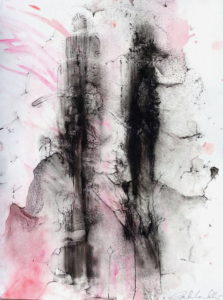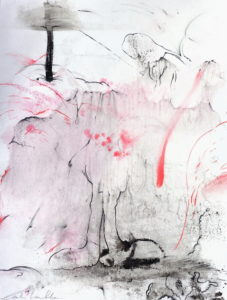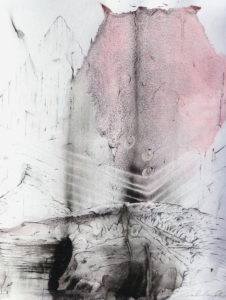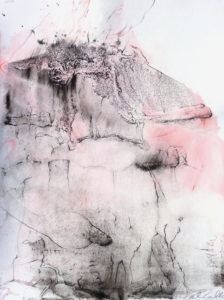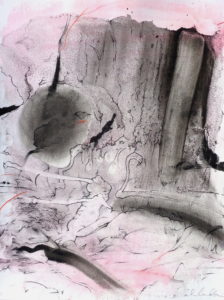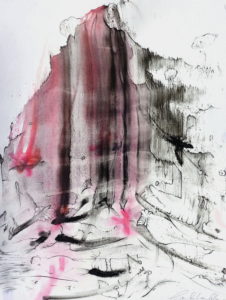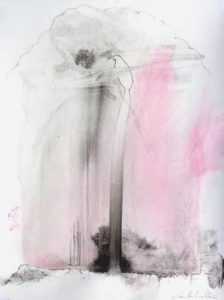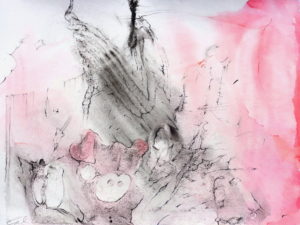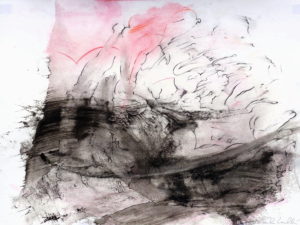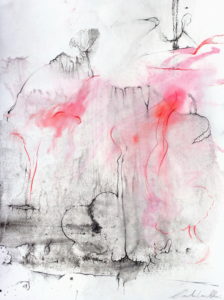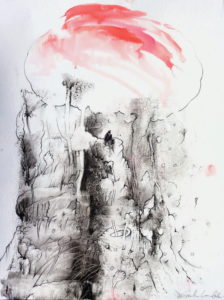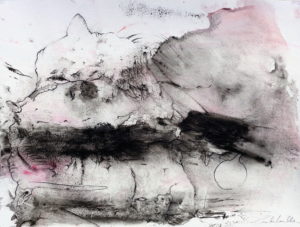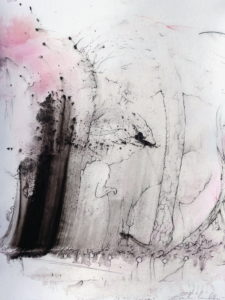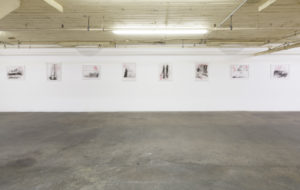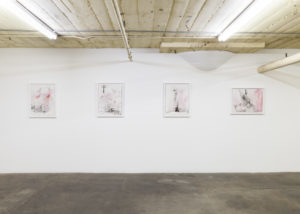Graham Lambkin: Marble on the Rot
- Graham Lambkin interviewed by Ethan Swan, May 2015
Ethan Swan: How are these drawings made?
Graham Lamkbin: This series was made on watercolor paper and the first step was to douse the paper in a 50/50 dilution of water/vinegar. Then the paper was treated to a mixture of India ink and watercolor paint, placed arbitrarily on the paper. One piece of paper was sandwiched against another and they were pulled, nudged or torn apart to create the movement of the ink, and also to help mix the mediums. The sheets were taken outside to my balcony to dry, sometimes for an hour, and sometimes overnight. The sunlight dries the ink on the vinegar, and somehow creates a marbleization effect where the pigments of the ink are forced to separate to greater or lesser degrees depending on the volume of vinegar and ink. Once dried I’d either repeat the process or I’d turn to colored pencils and carve out the forms. I wanted to be very conscious of the fact that with my last project, the children’s book Came to Call Mine, the images were very tight and the forms very identifiable. I wanted to step beyond that towards more suggestive forms, so if I became aware of the possibility that one arrangement could hold an animal or human form I would put down the minimum amount of information that was absolutely necessary for to convey the suggestion of their presence. There’s a point where figurative elements are melting in and out of the composition, and carried off in the smudge of ink before becoming fully realized. So they can be viewed as abstracted in a way but close inspection rewards the eye with the detailed elements that are embedded in each piece.
Do both sheets of paper become drawings? Or is one a drawing and the other discarded?
There was no mandate for what would happen to each piece of paper. Sometimes one or both would work out, sometimes not. Sometimes the print of the two sandwiched together would be used. Seeds Germinating, Twisting, and Figure in a Blizzard were sandwiched together and reveal their relationship to each other most obviously. They’re definitely a pair, and when hanging it was important to display this symmetry because it does aide the flow.
There are a couple of birds, there’s an elephant, a dolphin, the pig, a fox – there seem to be a lot of animal forms. And you’ve drawn animals a lot in the past, is that a place where you’re most comfortable? Or are there other reasons why this happens?
It’s simply the first thing that finds me. I don’t consciously think this would be another opportunity to work with animal forms, but my eye picks the shapes out and I feel it would be a betrayal of intent to ignore them. There’s also a lot of nature, mountainscapes. I don’t really do landscapes and things but that was the first thing that called out. It is a study of a natural world.
You make these in your house, what is the landscape surrounding that like? Is any of that reflected in the drawings?
Very much. You look out any window onto the tops of trees and we’re visited by animals all the time – squirrels and birds, which I make a point of encouraging through food. That’s probably something to do with it. My children are both fixed with the magisteria of the natural world, so it’s always on the calendar and just seemed the most obvious place to go.
At the moment that you pull the two sheets apart, how quickly does the paper orient itself? Do you have to turn the paper around a few times before the images emerge?
With something like Pearching, the composition could only work the way it does because of the weighted bottom, line – it doesn’t work any other way, and to counter that would have betrayed my intention of keeping the work light and aerated. Being able to pull back, was the biggest challenge, to know when to walk away and recognize the job done. There was so much more I could potentially see and do in the compositions, so it came down to just trusting my instinct on a case-by-case basis.
How did you come upon this technique of working with vinegar?
I’d actually used it before, but hadn’t been called to use it since. The illustrations for Came To Call Mine were all hard ink lines or pencil crayon so it’s a technique that I had to put to bed for awhile, but it seemed like a good opportunity, in light of what I said about wanting to keep the work looser to use it again. The process removes some of the responsibility from me in terms of the distribution and arrangement of the pigments. I couldn’t be so controlling and precious, and had to surrender myself to the possibility of accident.
Yesterday you described this workshop you did with CalArts students which asked students to work with happenstance, can you talk about your relationship with chance operations? Are you engaging the history of people like Duchamp or Gysin? Or it is more a strategy you’ve found that works for you.
Well I’m aware of that legacy, and if you don’t use it then you deny yourself the huge potential for expanded creative possibilities it carries. So placing yourself at the mercy of chance has always been a principal factor in whatever art I make.
With the Came to Call Mine book, I think a lot about the color palette for those drawings. Especially the color blue. But here you have a very reduced palette. How did you come to these specific colors? And do you have any thoughts about the variation in the red, from a pink to a very orange-red.
“Marble On The Rot” is in part a reaction to the color saturated work of Came To Call Mine which I was involved in for over a year. My natural instinct was to push back and do something more minimal. I liked the idea of reducing the palette or at least the color field. Like you said, it’s not just one red, there are multifarious combinations of reds, pinks, and orange. But it’s still within a narrow bandwidth compared to anything in that book. It’s one of those things where you realize the less you’ve got to work with the more thoroughly you can explore those individual options at hand. You can’t answer a problem by just changing colors, or ignoring the issue. You’ve just got red, black and white to reconcile, and that leads to some tougher questions but hopefully more satisfactory answers within the work.
This tactic of using the paper and vinegar, do you feel like you’ve explored it to the extent that you want to? Or is there more to discover? Like the ones where you’ve changed the rate of pulling them apart and how that creates a different mark. Are there more marks to find in this?
This is the start of something and because of that it’s the most exploratory, the most alive, and most naïve the work will ever likely be. The problem with pursuing this process further is the acquired understanding given that will inevitably lead to a desire to better control the freedoms inherent in the process, and the eventual reintroduction of the very order this work sets out to escape from. To continue would mean to fuse with new, unexplored takes on the process, and with luck ensure the continued and unmanaged growth of the project.
- Past Press

